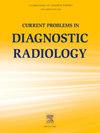What deters women from pursuing careers in interventional radiology: Factors associated with medical trainees decisions to pursue careers in IR
IF 1.5
Q3 RADIOLOGY, NUCLEAR MEDICINE & MEDICAL IMAGING
引用次数: 0
Abstract
Purpose
The purpose of this study is to understand the factors influencing a medical trainee's decision to pursue a career in Interventional Radiology (IR), and thereby to inform strategies to support the recruitment and retention of women in IR.
Materials and methods
Between April and August 2018, a 20-item survey was sent to all members of the Society of Interventional Radiology's Resident, Fellow, and Student section (SIR-RFS). Survey-weighted logistic regression models were constructed to quantify the association between key survey items and gender. Odds ratios and their 95% confidence intervals were computed to summarize each association. False-discovery rate adjusted p-values were computed to account for multiple comparisons.
Results
The survey had 567 respondents, corresponding to a 21% response rate. 51% of respondents were medical students, and 49% were radiology residents and fellows. Women comprised 26% of respondents. Women respondents were less likely to be interested in pursuing careers in IR (OR 1.73; 95% confidence interval (CI): 1.09-2.75; p=0.021, pFDR=0.104). Factors that women cited as deterrents to pursuing a career in IR included a desire to become pregnant (OR 4.80; 95%CI: 3.27-7.05; p/pFDR<0.001), a concern for gender-related bias (OR 12.13; 95%CI: 8.01-18.38; p/pFDR <0.001), a concern for ethnicity-related bias (OR 2.07; 95%CI: 1.38-3.09; p<0.001, pFDR=0.004), a concern for sexual-orientation related bias (OR 1.75; 95%CI: 1.04-2.93, p=0.035, pFDR=0.123), and lack of opportunity for professional advancement (OR 0.56; 95%CI: 0.38-0.84); p=0.006; pFDR=0.039).
Conclusion
Women trainees are less interested in pursuing careers in IR, citing a desire to have kids and gender-related bias as leading deterrents. Implementing interventions that target these disincentives will help support the recruitment and retention of women in IR.
是什么阻碍了女性从事介入放射学工作?受训医师决定从事介入放射学工作的相关因素
目的本研究旨在了解影响医学培训生决定从事介入放射学(IR)职业的因素,从而为支持介入放射学招聘和留住女性的策略提供信息。材料和方法在 2018 年 4 月至 8 月期间,向介入放射学会住院医师、研究员和学生分会(SIR-RFS)的所有成员发送了一份包含 20 个项目的调查。我们构建了调查加权逻辑回归模型,以量化关键调查项目与性别之间的关联。计算出的概率及其 95% 的置信区间概括了每种关联。为考虑多重比较,计算了经调整的假发现率 p 值。51%的受访者是医学生,49%是放射科住院医师和研究员。女性占受访者的 26%。女性受访者不太可能有兴趣从事红外职业(OR 1.73;95% 置信区间 (CI):1.09-2.75;P=0.021,PFDR=0.104)。女性认为阻碍从事投资者关系职业的因素包括:希望怀孕(OR 4.80;95%CI:3.27-7.05;p/pFDR<0.001)、担心与性别相关的偏见(OR 12.13;95%CI:8.01-18.38;p/pFDR<0.001)、担心与种族相关的偏见(OR 2.07;95%CI:1.38-3.09;p<0.001,pFDR=0.结论女性受训者对从事投资者关系职业的兴趣不大,她们认为生孩子的愿望和与性别相关的偏见是主要的阻碍因素。针对这些阻碍因素实施干预措施将有助于支持招募和留住IR领域的女性。
本文章由计算机程序翻译,如有差异,请以英文原文为准。
求助全文
约1分钟内获得全文
求助全文
来源期刊

Current Problems in Diagnostic Radiology
RADIOLOGY, NUCLEAR MEDICINE & MEDICAL IMAGING-
CiteScore
3.00
自引率
0.00%
发文量
113
审稿时长
46 days
期刊介绍:
Current Problems in Diagnostic Radiology covers important and controversial topics in radiology. Each issue presents important viewpoints from leading radiologists. High-quality reproductions of radiographs, CT scans, MR images, and sonograms clearly depict what is being described in each article. Also included are valuable updates relevant to other areas of practice, such as medical-legal issues or archiving systems. With new multi-topic format and image-intensive style, Current Problems in Diagnostic Radiology offers an outstanding, time-saving investigation into current topics most relevant to radiologists.
 求助内容:
求助内容: 应助结果提醒方式:
应助结果提醒方式:


